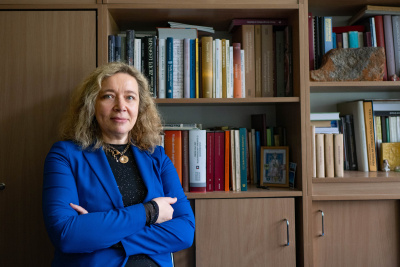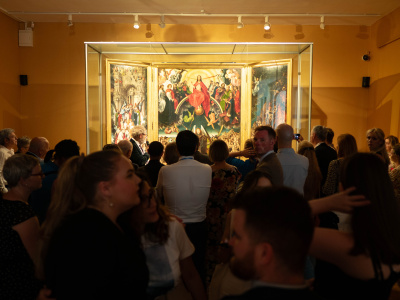
After a year and a half of operation, the Memling Research Centre can boast cooperation with many foreign scholars, interesting conferences organised and numerous popular science initiatives - from the lecture series 'Around Memling' to the ongoing art competition 'How Paul Beneke acquired the famous Last Judgement for Gdańsk'. We talk about the importance of Memling for Gdańsk and the work of the centre established in October 2022 with its Director prof. dr hab. Beata Możejko.
Marcel Jakubowski: - The name 'Memling Research Centre' suggests that you are investigating strictly scientific issues here; is this the only thing the Centre does?
Prof. Beata Możejko: - We have three objectives. Firstly, research, i.e. all kinds of queries resulting in scientific papers, books and conferences. Secondly, to popularise knowledge about Memling, about The Last Judgement, Gdańsk or the Hanseatic League in Memling's time - in other words, Memling in all its forms. Thirdly, the most difficult part of our activities, that is, door-to-door education, e.g. by giving lessons to secondary schools. We recently organised an art competition aimed at primary and secondary school children entitled ‘How Paul Beneke won the famous Last Judgement for Gdańsk’.
- Is Hans Memling the subject of interest only to medievalists?
- No, if only because the Last Judgement itself has a rich history dating back to modern times. Tsar Peter I, ruling at the turn of the 18th century, wanted to take this painting out of Gdańsk as a 'gift', but the people of Gdańsk did not agree. During the Napoleonic era, The Last Judgement was taken to the Louvre, and during World War II the work was again taken out of Gdańsk and hidden in East Germany. There the Soviet army found it and took it with them to the USSR, so this story goes back to the 20th century. We work not only with those involved in medieval history and art but also with modern and contemporary art. Our team includes researchers working on aspects related to the law and aesthetics of the works, such as prof. Kamil Zeidler and dr Joanna Kamień.

- What research questions are you looking for answers to?
- We are looking into the question of Gdańsk's relationship with Bruges, the city where Memling did most of his work, the repercussions of the acquisition of The Last Judgement for Gdańsk, and Gdańsk's relationship with Lübeck, whose inhabitants commissioned the last painting Memling completed. On top of this, we continue to study The Last Judgement from an artistic point of view: we are looking for clues and references to history or other works of art. We also want to determine Hans Memling's influence on Italian and Spanish art, but also on Danzig, as the presence of the triptych in our city had quite an impact on both local artists and the residents themselves. Currently, our research into the history of the Last Judgement is hampered due to the war in Ukraine. We are unable to go to the archives in St Petersburg, where there is certainly interesting documentation. For the next few years, this final topic will certainly be frozen.
- What role does the Last Judgement play in the construction of Gdańsk's regional identity?
- For many foreign scholars I have spoken to, it is obvious that The Last Judgement is Hans Memling's best work. Unfortunately, it seems to me that this awareness is not present among Danzigers. According to me and many other scholars, it is not only the best work in Gdańsk, but next to Leonardo Da Vinci's Lady with an Ermine, it is the most important work in Poland. While the Early Art Department of the National Museum in Gdańsk is not happily located in the context of a tourist route, this fact does not justify the fact that Gdańsk residents do not identify with the whole great history of the triptych. On the one hand, we have the maritime aspect, namely the corporal Paul Beneke and his action to acquire the work, and on the other, the great cultural value of the Last Judgement and the pride that it is in Gdańsk that this painting is located. Of course, there are still discussions among researchers about the legality of Paul Beneke's acquisition of the triptych, i.e. the distinction between piracy and caperism.
- How do the people of Gdańsk react to this story? Do your initiatives such as popular science lectures or the debate for secondary school students ‘Paul Beneke: caper or pirate?’ meet with great interest?
- There is a certain group of listeners who are interested in Gdańsk's history and regularly attend our lectures. On the other hand, some people have heard something, that there is a Last Judgement in Gdańsk, but nothing else. When these audiences find out that there is a great maritime history behind the presence of the triptych in our city, they are very surprised; they say it's history for a film. We enjoy this interest in lectures enormously; all the questions are valuable. In schools, on the other hand, when I ask the pupils how many of them have seen the Last Judgement in the museum, it is a maximum of a few pupils. Then you have to explain everything from the ground up, i.e. what the Hanseatic League was, why Gdańsk was involved in all this, and why it is difficult to judge Paul Beneke's work from our point of view, let alone the importance of the artistic details of Memling's painting. This telling of the painting through the story surrounding it is intended to encourage students and teachers to go, whether as part of their school or privately, to the National Museum in Gdańsk. We are currently working very well with schools in Gdańsk: University High School, 1st High School, 15th High School and 19th High School. I would like young people to see that Gdańsk is a city of freedom and solidarity not only because of the events of the 1980s but that this idea of freedom has been present in our city since the late Middle Ages.
- As the Memling Research Centre, do you publish the results of your research?
- One of the Centre's first activities was to host a conference on the body. A volume that is the aftermath of this event will soon be published as part of the 'Studia Historica Gedanensia'. It will include articles by foreign researchers, but also by a team from the Centre, such as Prof. Andrzej Woziński. In turn, after last year's conference on Memling, we are preparing a volume for the Brepols publishing house, a large publishing house with an international reach. The volume will probably be published in 2025.
- To what extent does the subject of Hans Memling have international potential?
- Huge potential, but we are only at the beginning, we have been active for a little over a year. We want to promote our work at international events, hence our presence at the Medievalist Congress in Leeds, among others. More than 2,000 people come there every year, although of course not all of them attended our panel, as many of the presentations are held there in parallel. On the other hand, we let the world know that our Centre was established and operating in Gdańsk. As a result of these conferences, we are already slowly beginning to sign declarations of cooperation. Our partners take part, for example, in the History Faculty's lecture series ‘Friday at the History Faculty’. Last academic year we hosted researchers from Hamburg and Lübeck, prof. dr Ulla Kypta and dr Angela Huang, and prof. Jack Hartnell from the University of East England. This year, we had prof. Emilia Jamroziak from the University of Leeds, prof. Felicitas Schmieder from Fern Universität in Hagen and now prof. Balázs Nagy from the Central European University in Vienna. We had these international contacts before, but thanks to the Memling Research Centre we have been able to strengthen them.
- Where does your fascination with Memling come from?
- It stems from my research. Some time ago, I wrote a monograph on the history of the caravel 'Peter von Danzig', which, under the command of Paul Beneke, attacked and seized the galley that carried, among other things, the Last Judgement. In dealing with the history of this ship, I also had to deal with the history of the painting. I owe my interest in the painting, pathetic though it may sound, to my mother, who used to take me and my brother, when we were still children, to the National Museum in Gdańsk. This is also one of the reasons why I encourage students to see this triptych. I myself am an example that such a visit can have a great effect.
